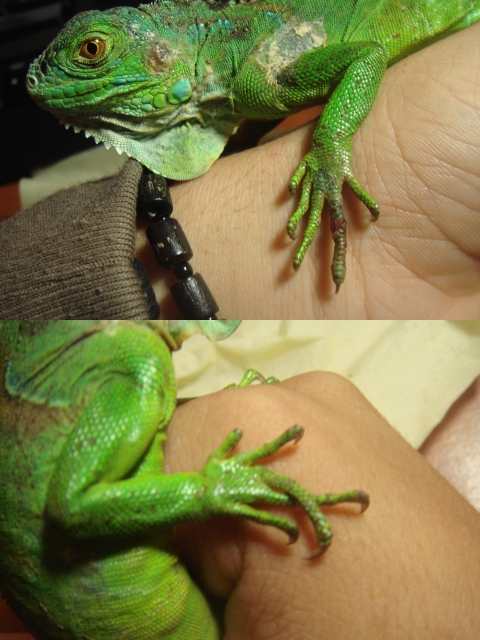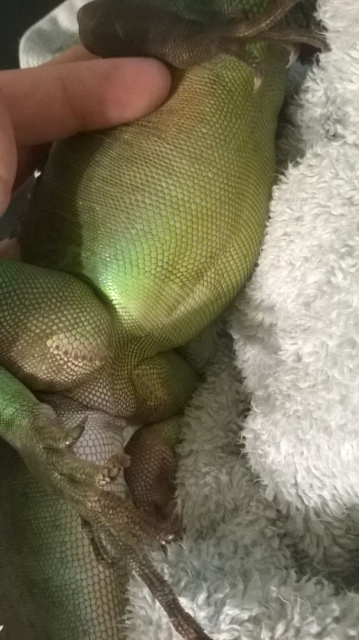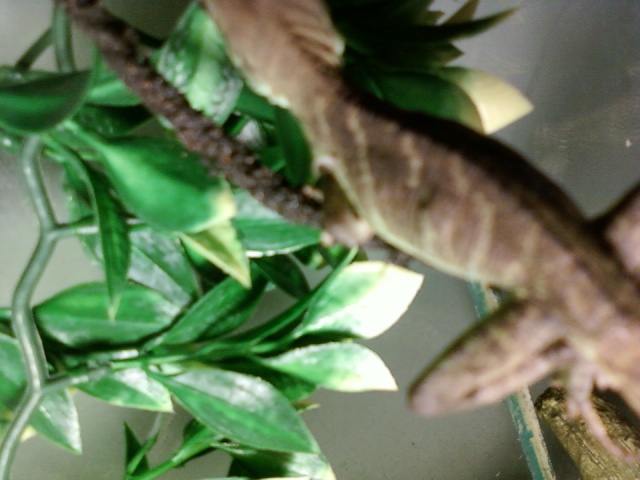QuestionI guess I will start from the begening, My cousin and I were catching green anoles (we live in south carolina and they are always in abundant supply here) We were just catching for fun then letting them go and I would carefully show her the lizards and teach her to be gentle(she is 4) I had no intention to keep any my parents would die if i brought home another pet, anyhow that all changed when I saw a fairly small anole with a large fresh gash that left his arm dangling and a small cut on his leg. My theory is perhaps a cat got him and he escaped, but i will never know. So I carefully put him in a little bug caching crate and carried him home I fed him roly polys (pill bugs) and what ever i could find and i had to force feed him because he wouldnt hunt them and force him to drink. I knew a lady who was good with reptiles and i contacted her and i sonn amputated his left front leg because there was no bone connecting it to the shoulder. so for about 3-4 months he lived in that little crate with leaves and rocks and i bought him crickets that i had to force feed. But i got some string and made a 'harness'and a leash and i would take him out side on warm days to let him explore in the woods. So until yesterday that was a breif overveiw of his life. My family grew to love him and finally they believed me when i told them for the millionth time his leg couldnt grow back like his tail could. so I finally got a 10 gal. aquarium to put tim in, I put dirt in the bottom and mixed it with potting soil and i got pothos plant to grow in there, we cut branches from the woods, planted moss and monkey grass and put a large rock and a small rock in and i put my hot desk lamp over it too. So I put him in and he seems to have alredy livened up a bit. But i was wondering if i should continue to force feed him or give him crickets so he can hunt i am not sure hif he will be able to hunt well with 3 legs.he dosnt move fast unless you force him. also I was wondering if the setup was 3-leg friendly, he really loves his big rock. I am not sure if it is a boy or a girl, it is mid sized and i didnt see enlarged scales below the vent or the bump below the tail, and it sometimes has a grayish brown stripe down its back so assume leg-a-less is a girls but i am not sure. One more question, leg-a-less seems slightly depereesed, will he get better now that he has a big tank, or i got her from a large colony do you think i should but another (a girl of course) Sorry this was such a long message! I just wanted you to have enough background knowledge to assess the situation.
Thank you SOOOO much
-Briana & Leg-a-less
Answer It sounds like Leg-a-less may have gone through enough stress from his injury and capture to probably have a high parasite gutload. He really should be seen by a good reptile veterinarian. Let the vet check for parasites and examine the amputated area for any possible infection. Stop force feeding him. It is winter and normally many reptiles go through a semi-hibernation, so he may not have been very hungry and had wanted to sleep.
I'm giving you a proper caresheet:
ANOLE CARESHEET
Adult anole size is up to 9 inches.
Males generally have a larger dewlap than females. Males are larger than females. Males have a brighter, larger red throat,Females MAY keep the stripe down their back. Mature males have a hemipenes bumps on either side of their tail base.I believe anoles are considered mature when they reach about 5 inches snout to tail tip length.
TEMPERATURES:
They need a basking area temperature gradient of 85-92 degrees. These temperatures are needed to properly digest their foods. The basking area is one area of their cage. The overall or ambient temperature of their tank gradient upper 70-s to 80 degrees. 75 degrees for a cool area. Temperatures of 65-75 at night is fine. NEVER use heat rocks or heat caves for Anoles!! They malfunction and will cause death to the anole.
LIGHTING:
Anoles need UVB, which is the special lights
that come in fluorescent tubes
UVB is needed by the anoles
to be able to absorb the calcium in the foods they eat.
With out the uvb, they will develop metabolic bone disease.
With the tubes, they must say that they produce BOTH uvb and
uva. The uvb needs to be 5% or higher. Repti Sun 5.0 are
one of the best uvb tubes on the market. The repti glo 8.0's are testing out to be a great uvb source also.There are tubes
that say ''full spectrum'' but they do not produce any uvb.
These need to be positioned 6-8 inches over the anole so
that they get the uvb that is needed. The tubes need to be replaced every 6-9 months as that they stop producing uvb long before they stop producing light.
For daytime heat, if using the tube uvb, regular household
incandescent lightbulbs produce heat. The wattage will
depend on the size of your anoles enclosure. At night you need to provide a heat source in the form of a ceramic
heat emitter(which can also be used during the day) or a
special nighttime bulb(red or deep purple) that does not
produce any bright white light if the temperatures drop below the recommended night temperatures.
DIET:
Anoles eat daily. They are insectivores. Their food must not be too big for them (no larger than 1/2 the size of their head. All insects that are fed to them must be properly gut loaded for at least 48 hours before feeding them. Crickets, silk worms,trevo worms, wax worms are all part of their varied diet. Many will even eat babyfood fruits and possibly the meats. They are used as treats(once or twice a wk) and are wonderful for hydration. The Gut loading is feeding the insects a nutritious diet prior to feeding the insects to the anoles. This can be accomplished with feeding a recommended "diet" for the insect. ( http://www.anapsid.org/feedingbugs.html ) The crickets can be fed vegetables and cereals. Chicken laying mash is a good choice of food for the crickets as are other commercial foods designed for crickets.Their food needs to be dusted with calcium powder (rep cal calcium with no added phosphorus or vitamin D3 is a good brand) two times a week. Some may eat a bite or two of fruit. A vitamin should be used once a week. Rep Cal Herptivit is a good brand. Be sure to remove any crickets your anole has not eaten after 20 minutes or so to prevent the crickets from nibbling on your anole. Keeping your crickets well fed will help prevent this.
HOUSING:
A 20 gallon tall or larger tank or mesh vivarium is recommended for an Anole. As with almost all reptiles, its best to house them separately. Males can NEVER be housed together as they will fight over territory. Females MAY get along, but doesn't always happen.
Provide several basking branches and plants (silk and plastic)for your Anole. Be sure that all plants and branches are well anchored. For substrate(flooring) the best is plain unprinted newspaper or paper towels... its cheap and easy to clean..and the best part is its safe. Paper towels and lizard carpeting may also be used.
Stress is the usual cause of an anole turning brown. Stress with them can be caused by incorrect temperatures, other animals that they see, incorrect or no uvb, housing problems (not "natural" enough for them with plenty of plants, etc) housing two males together, (or just two that do not get along)tank not large enough ( for two anoles(male and female or possibly two females)
WATER:
Their water consumption is from dripping leaves. Misting the tank is important. Humidity needs to be in the 60-70 % range. Be sure to provide a small dish of fresh drinking water daily.
This is by no means a complete caresheet on anoles. Please be sure to check out the following link for more in-depth anole care.
http://www.kingsnake.com/anolecare/5.htm
Also, its a good idea to find a Vet before one is actually needed. Reptiles need vets that are trained to treat them. You can find a vet in your area by going to
http://www.anapsid.org/vets/

 Female beardie
Question
Igor
Hi there,
Can it be detrimental for my fe
Female beardie
Question
Igor
Hi there,
Can it be detrimental for my fe
 Whites Tree Frog Eye Problem
QuestionTree Frog
QUESTION: i special ordered a
Whites Tree Frog Eye Problem
QuestionTree Frog
QUESTION: i special ordered a
 Iguana toe problem...
Question
toe problems
Hey there,
I adopted a baby iguan
Iguana toe problem...
Question
toe problems
Hey there,
I adopted a baby iguan
 xerxes
Question
xerxes xerxes
Sorry for lack of i
xerxes
Question
xerxes xerxes
Sorry for lack of i
 Chinese Water Dragon Broken Rib??
Question
Side Lump
Hi,
My fiance and I have a chinese w
Chinese Water Dragon Broken Rib??
Question
Side Lump
Hi,
My fiance and I have a chinese w